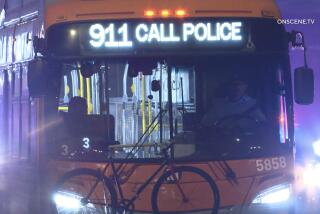MTA Strike’s 2nd Day Goes by the Rules : Labor: Union members block vehicles at Sun Valley bus depot. But the route delays are restricted to four minutes each.
SUN VALLEY — Everyone seemed to have a rough idea of the rules: The strikers agreed to hold up departing buses for four minutes, no more, no less. The supervisors who had replaced them in the driver’s seats waited patiently, joking with the strikers before getting permission to move on. And police kept their distance, choosing the comfort of their air-conditioned squad cars.
“We don’t really mind; we understand the situation,” said a smiling supervisor, who was filling in as a driver.
“All we’re trying to do is to detain them a little,” said a grinning Robert Blackwood, a striking bus mechanic. “They understand what we have to do.”
“We’re just here to make sure everything goes smoothly,” Los Angeles Police Officer Todd Trulock said with a shrug.
And so it went at a picket line at the Metropolitan Transportation Authority’s Sun Valley bus depot Tuesday--the second day of a strike against the agency by its mechanics, which is also being honored by drivers and clerks.
During a day when all suffered under the same hot sun, there was a strange camaraderie between the 40 or so strikers and their bosses--even as union members tried to block buses by standing in front of them for as long as possible, while their bosses wanted nothing more than to get to their routes.
“We were holding them up for seven or 10 minutes earlier this morning,” said Blackwood, who made sure that the drivers knew the holdup was not personal by bidding each of them a good day. “But they (the police) cut it to about four.”
Sometimes, though, the agreed-upon four-minute delay actually stretched to a quarter of an hour without anyone seeming to notice.
While waiting for cars and buses to block, the strikers talked about their greatest concern: the MTA’s growing reliance on subcontracting duties that union members had previously performed. Their other big worry is that the public perceives them as overpaid and spoiled.
“(The MTA) says we’re in a hole,” bus driver and shop steward Ed Hanger said. “But hey, we didn’t do it. We didn’t tell them to put all their money in rail and . . . spend thousands of dollars on newspaper ads attacking the union.”
Added Steve Patterson, an MTA service attendant: “They’re trying to balance their budget on the backs of guys making $30,000 or $40,000 a year. Why not start the cost-cutting at the top?”
While the strikers remained mostly good-natured on their second day out, occasionally they applied the heat.
“You are crossing the picket line, and we’ve asked you not to,” Dane Sheldon, an executive board member of the striking Amalgamated Transit Union Local 1277, said as a substitute driver tried to exit the bus yard. “You don’t have anything to lose here?”
After the driver turned away, Sheldon backed off. “I was pushing it a little, huh?” he asked sheepishly.
By late morning, they were told that a Los Angeles police captain had surveyed their strike line and was unhappy about it. “He said what we are doing is illegal,” Sheldon informed the group. “We need to walk a line, or he’s going to arrest somebody for blocking the street.”
So the strikers started walking back and forth, causing largely the same result: No cars or buses could come in or out of the bus yard without waiting four minutes--or thereabouts.
Meanwhile, outside the San Fernando Valley’s other MTA depot, in Chatsworth, there was precious little goodwill Tuesday afternoon.
Because the MTA wasn’t driving any buses out of that yard, a dozen strikers--including drivers, mechanics and clerks--had plenty of time to fume.
The drivers said stress is unavoidable in their profession, with its tight schedules, complaining passengers and the occasional armed motorist aiming a gun at an MTA driver. Some said they were angry enough to vote against the tentative agreement that the driver’s union reached last week.
“You give me another choice for a job and, if I make the same money, I’ll be flying out of there,” said Guillermo Munoz, a driver for 14 years. “We get no respect, and we’ve had it.”
Valley Emergency Bus Routes
For the duration of the strike, the Metropolitan Transportation Authority has established emergency service on seven of the San Fernando Valley’s busiest routes.
There are fewer buses on those lines, however, and MTA officials cautioned passengers to expect to wait twice as long as usual between buses. For example, they said, if a bus normally reaches a particular stop every 20 minutes, buses on the emergency lines will probably arrive up to 40 minutes apart.
The buses also run shorter hours, from 6 a.m. to 6 p.m. only. All buses on the Valley routes are free except those on the Van Nuys Boulevard line, which cost 50 cents.
Key to Valley Transportation
92
240
163
420
424-425
560
Metrolink Station
*
Scheduling Information
For bus:
call 1-800-2LA-RIDE
(1-800-252-7433)
For Metrolink
call 1-800-371-LINK
(1-800-371-5465)
Source: Metropolitan Transportation Authority
More to Read
Sign up for Essential California
The most important California stories and recommendations in your inbox every morning.
You may occasionally receive promotional content from the Los Angeles Times.









